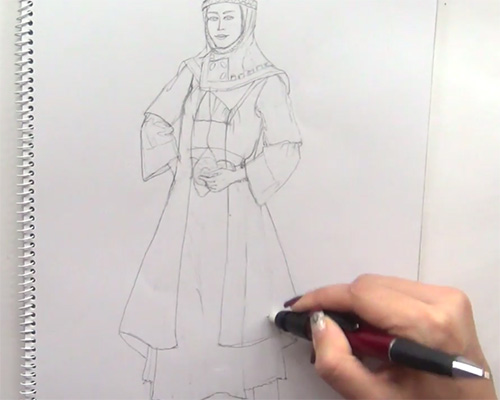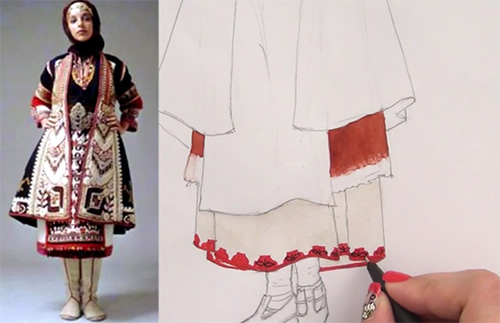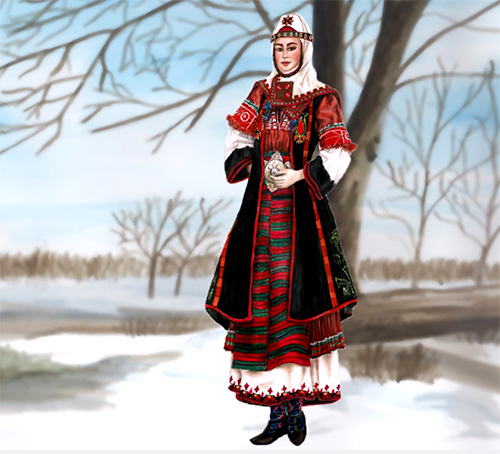 The traditional costumes of Bulgaria are rich in details: weaving patterns, various embroidery designs, and patterns on the fabric. The color palette is also bright and cheerful, though the number of colors is rather limited. All of those features make Bulgarian folk outfits potentially suitable and interesting for artists and illustrators. Have you ever tried to paint folklore clothes, even if just for fun? If not, you definitely need to try.
The traditional costumes of Bulgaria are rich in details: weaving patterns, various embroidery designs, and patterns on the fabric. The color palette is also bright and cheerful, though the number of colors is rather limited. All of those features make Bulgarian folk outfits potentially suitable and interesting for artists and illustrators. Have you ever tried to paint folklore clothes, even if just for fun? If not, you definitely need to try.
The national costumes were worn in Bulgarian villages until the beginning of the 20th century. These garments were hand made in the villages using materials that were produced locally. Bulgarian women made their costumes all by themselves. Once married, it was usual in the past for a bride to be taken to her husband's village taking with them her dowry, and her folk costume was a part of it. Later, her costume was passed on as a gift to her daughter.

Bulgarian folk costumes consist of pants, shirts, vests, and girdles for men and dresses and aprons for women. To all types of female costumes, there were specific hair styles and arrangements of the head-clothing, featuring jewelry, caps, scarves, and flowers.
While female costumes are defined by the shape and cut of the dress, the male costumes are divided according to the shape and color of the upper garments in two principal types: white-garment and black-garment. Commonly, female costumes are divided into four categories: one-apron, two-apron clothes, tunics, and the Saya garment.

The garment I'm about to show you today is a young bride’s winter costume from the second half of the 19th century, from Southeastern Thrace. The dress is a tunic or “soukman”, as we call it in Bulgarian. It was the most widely spread female costume and consisted of a chemise on top of which was worn the tunic made of a home-spun frieze, closed in the front.
On the left-hand side, you can see the original garment I used as a reference for my illustration. As it's a winter costume she wears a scarf and a coat over the dress.
I decided to make two drawings just to show you how the actual garment looked like without being covered by additional clothing pieces. For the scarf, I use a fairly diluted burnt sienna to achieve the beige tone of the fabric and brown for the shadows. As I apply the shadows, I use a second wet clean brush to soften and blend the brown color into the beige. For all embroidery on the garment, I use fine liners and ProMarkers because they are very precise when you render fine details.

I repeat the same technique shown before to render the chemise. As the chemise is made of a thick fabric, it creases in large and clean shapes, but the shadows are still soft because it's probably cotton.
The tunic is in two colors: bright red and orange-red, with greenish-white embroidery at the neckline and the hem of the skirt. The aprons, dresses, and shirts are usually embroidered in regional colors and folk motifs. Red features are heavily used in Bulgarian folk dress, but black, green, and white are also a part of the traditional clothing. Just in the same manner, the decorations at the chemise's sleeves repeat on the very bottom of it in the same reddish-black color scheme.
Here is another reference picture I used to construct the costume.
The traditional materials were linen, hemp, wool, silk, and cotton. The tunic is made of woolen fabric, and the shadows are larger and fewer because of the thickness of the material. It appears and creases almost like suede leather.

The soukman dress was worn with an apron fastened in the front with a belt with large belt buckles.
The ornamentation of this costume is concentrated on the hem of the skirt, on the neckline and the sleeves' borders. It's the costume's ornaments that make it so beautiful and unique.
The Bulgarian costumes contain many elements and motifs from the pagan beliefs and legends. No one wore clothes with fully symmetrical decorations because Bulgarians believed that full symmetry was a diabolical creation. Therefore, elements were often added and removed, so that no symmetry should exist. Those were intentional mistakes in order to prevent the evil eye.

The basic structure of the clothing worn by men and women for workdays and holidays remained the same for many hundreds of years, until the urbanity influenced fashion and factory produced clothes became available.
The coat is very simple. I just fill it in with black paint by leaving out the orange stripes and the seams.
I didn't spend much time on rendering the leather shoes and the socks.
Here is the finished result with and without the head covering and the coat.
(c) Fashion ARTventures


